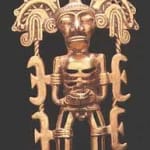Sinu Gold Pendant of a Man Dressed in a Ceremonial Costume, 600 CE - 1600 CE
Gold
2.5 x 3.75
FJ.6234
Gold played a very important role in the ceremonial activity of the peoples of Gran Zenu. As emblematic ornaments and religious/funerary offerings they helped reaffirm the prestige of the chieftains...
Gold played a very important role in the ceremonial activity of the peoples of Gran Zenu. As emblematic ornaments and religious/funerary offerings they helped reaffirm the prestige of the chieftains and priests who controlled both the sacred and secular aspects of society. When worked into artistic forms, gold was believed to acquire power or energy of a supernatural nature, and therefore suitable as offerings to the gods. This extraordinary figure appears to be making just such an offering, held in a bowl pressed tightly against his stomach. A combination of different attributes indicates he is a shaman or priest dressed in ritual costume for a great ceremony. His magnificent headdress begins with a conical-shaped centerpiece, then bursts out in a maelstrom of intricate shapes, cascading down to just above the feet. This may represent an actual headdress made of feathers, hide and even gold, attached to the man's arms and legs so it would not move about while he walked. The face is a study in solemnity and dignity, expressed so profoundly by the closed eyes and compressed mouth. Understood in this context, this pendant becomes much more than a piece of jewelry. It is a veritable visual record of an esoteric ritual, long since forgotten; brought back from darkness into the light untarnished and gleaming with natural brilliance and a supernatural mystery.



